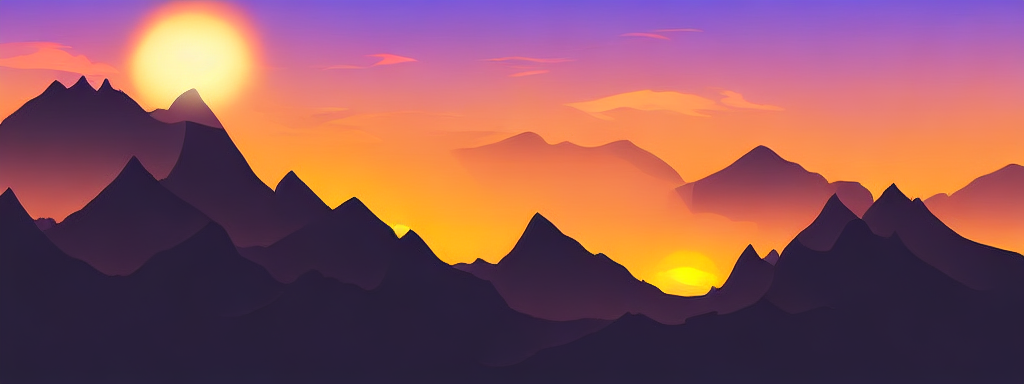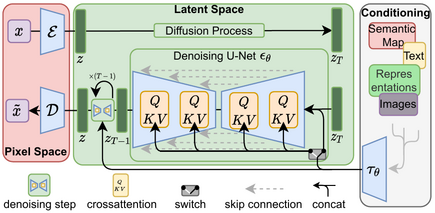High-Resolution Image Synthesis with Latent Diffusion Models
Robin Rombach*,
Andreas Blattmann*,
Dominik Lorenz,
Patrick Esser,
Björn Ommer
* equal contribution
-
Thanks to Katherine Crowson, classifier-free guidance received a ~2x speedup and the PLMS sampler is available. See also this PR.
-
Our 1.45B latent diffusion LAION model was integrated into Huggingface Spaces 🤗 using Gradio. Try out the Web Demo:
-
More pre-trained LDMs are available:
- A 1.45B model trained on the LAION-400M database.
- A class-conditional model on ImageNet, achieving a FID of 3.6 when using classifier-free guidance Available via a colab notebook
.
A suitable conda environment named ldm can be created
and activated with:
conda env create -f environment.yaml
conda activate ldm
A general list of all available checkpoints is available in via our model zoo. If you use any of these models in your work, we are always happy to receive a citation.
Download the pre-trained weights (5.7GB)
mkdir -p models/ldm/text2img-large/
wget -O models/ldm/text2img-large/model.ckpt https://ommer-lab.com/files/latent-diffusion/nitro/txt2img-f8-large/model.ckpt
and sample with
python scripts/txt2img.py --prompt "a virus monster is playing guitar, oil on canvas" --ddim_eta 0.0 --n_samples 4 --n_iter 4 --scale 5.0 --ddim_steps 50
This will save each sample individually as well as a grid of size n_iter x n_samples at the specified output location (default: outputs/txt2img-samples).
Quality, sampling speed and diversity are best controlled via the scale, ddim_steps and ddim_eta arguments.
As a rule of thumb, higher values of scale produce better samples at the cost of a reduced output diversity.
Furthermore, increasing ddim_steps generally also gives higher quality samples, but returns are diminishing for values > 250.
Fast sampling (i.e. low values of ddim_steps) while retaining good quality can be achieved by using --ddim_eta 0.0.
Faster sampling (i.e. even lower values of ddim_steps) while retaining good quality can be achieved by using --ddim_eta 0.0 and --plms (see Pseudo Numerical Methods for Diffusion Models on Manifolds).
For certain inputs, simply running the model in a convolutional fashion on larger features than it was trained on
can sometimes result in interesting results. To try it out, tune the H and W arguments (which will be integer-divided
by 8 in order to calculate the corresponding latent size), e.g. run
python scripts/txt2img.py --prompt "a sunset behind a mountain range, vector image" --ddim_eta 1.0 --n_samples 1 --n_iter 1 --H 384 --W 1024 --scale 5.0
to create a sample of size 384x1024. Note, however, that controllability is reduced compared to the 256x256 setting.
The example below was generated using the above command.

Download the pre-trained weights
wget -O models/ldm/inpainting_big/last.ckpt https://heibox.uni-heidelberg.de/f/4d9ac7ea40c64582b7c9/?dl=1
and sample with
python scripts/inpaint.py --indir data/inpainting_examples/ --outdir outputs/inpainting_results
indir should contain images *.png and masks <image_fname>_mask.png like
the examples provided in data/inpainting_examples.
Available via a notebook .

We also provide a script for sampling from unconditional LDMs (e.g. LSUN, FFHQ, ...). Start it via
CUDA_VISIBLE_DEVICES=<GPU_ID> python scripts/sample_diffusion.py -r models/ldm/<model_spec>/model.ckpt -l <logdir> -n <\#samples> --batch_size <batch_size> -c <\#ddim steps> -e <\#eta> For downloading the CelebA-HQ and FFHQ datasets, proceed as described in the taming-transformers repository.
The LSUN datasets can be conveniently downloaded via the script available here.
We performed a custom split into training and validation images, and provide the corresponding filenames
at https://ommer-lab.com/files/lsun.zip.
After downloading, extract them to ./data/lsun. The beds/cats/churches subsets should
also be placed/symlinked at ./data/lsun/bedrooms/./data/lsun/cats/./data/lsun/churches, respectively.
The code will try to download (through Academic
Torrents) and prepare ImageNet the first time it
is used. However, since ImageNet is quite large, this requires a lot of disk
space and time. If you already have ImageNet on your disk, you can speed things
up by putting the data into
${XDG_CACHE}/autoencoders/data/ILSVRC2012_{split}/data/ (which defaults to
~/.cache/autoencoders/data/ILSVRC2012_{split}/data/), where {split} is one
of train/validation. It should have the following structure:
${XDG_CACHE}/autoencoders/data/ILSVRC2012_{split}/data/
├── n01440764
│ ├── n01440764_10026.JPEG
│ ├── n01440764_10027.JPEG
│ ├── ...
├── n01443537
│ ├── n01443537_10007.JPEG
│ ├── n01443537_10014.JPEG
│ ├── ...
├── ...
If you haven't extracted the data, you can also place
ILSVRC2012_img_train.tar/ILSVRC2012_img_val.tar (or symlinks to them) into
${XDG_CACHE}/autoencoders/data/ILSVRC2012_train/ /
${XDG_CACHE}/autoencoders/data/ILSVRC2012_validation/, which will then be
extracted into above structure without downloading it again. Note that this
will only happen if neither a folder
${XDG_CACHE}/autoencoders/data/ILSVRC2012_{split}/data/ nor a file
${XDG_CACHE}/autoencoders/data/ILSVRC2012_{split}/.ready exist. Remove them
if you want to force running the dataset preparation again.
Logs and checkpoints for trained models are saved to logs/<START_DATE_AND_TIME>_<config_spec>.
Configs for training a KL-regularized autoencoder on ImageNet are provided at configs/autoencoder.
Training can be started by running
CUDA_VISIBLE_DEVICES=<GPU_ID> python main.py --base configs/autoencoder/<config_spec>.yaml -t --gpus 0,
where config_spec is one of {autoencoder_kl_8x8x64(f=32, d=64), autoencoder_kl_16x16x16(f=16, d=16),
autoencoder_kl_32x32x4(f=8, d=4), autoencoder_kl_64x64x3(f=4, d=3)}.
For training VQ-regularized models, see the taming-transformers repository.
In configs/latent-diffusion/ we provide configs for training LDMs on the LSUN-, CelebA-HQ, FFHQ and ImageNet datasets.
Training can be started by running
CUDA_VISIBLE_DEVICES=<GPU_ID> python main.py --base configs/latent-diffusion/<config_spec>.yaml -t --gpus 0,where <config_spec> is one of {celebahq-ldm-vq-4(f=4, VQ-reg. autoencoder, spatial size 64x64x3),ffhq-ldm-vq-4(f=4, VQ-reg. autoencoder, spatial size 64x64x3),
lsun_bedrooms-ldm-vq-4(f=4, VQ-reg. autoencoder, spatial size 64x64x3),
lsun_churches-ldm-vq-4(f=8, KL-reg. autoencoder, spatial size 32x32x4),cin-ldm-vq-8(f=8, VQ-reg. autoencoder, spatial size 32x32x4)}.
All models were trained until convergence (no further substantial improvement in rFID).
| Model | rFID vs val | train steps | PSNR | PSIM | Link | Comments |
|---|---|---|---|---|---|---|
| f=4, VQ (Z=8192, d=3) | 0.58 | 533066 | 27.43 +/- 4.26 | 0.53 +/- 0.21 | https://ommer-lab.com/files/latent-diffusion/vq-f4.zip | |
| f=4, VQ (Z=8192, d=3) | 1.06 | 658131 | 25.21 +/- 4.17 | 0.72 +/- 0.26 | https://heibox.uni-heidelberg.de/f/9c6681f64bb94338a069/?dl=1 | no attention |
| f=8, VQ (Z=16384, d=4) | 1.14 | 971043 | 23.07 +/- 3.99 | 1.17 +/- 0.36 | https://ommer-lab.com/files/latent-diffusion/vq-f8.zip | |
| f=8, VQ (Z=256, d=4) | 1.49 | 1608649 | 22.35 +/- 3.81 | 1.26 +/- 0.37 | https://ommer-lab.com/files/latent-diffusion/vq-f8-n256.zip | |
| f=16, VQ (Z=16384, d=8) | 5.15 | 1101166 | 20.83 +/- 3.61 | 1.73 +/- 0.43 | https://heibox.uni-heidelberg.de/f/0e42b04e2e904890a9b6/?dl=1 | |
| f=4, KL | 0.27 | 176991 | 27.53 +/- 4.54 | 0.55 +/- 0.24 | https://ommer-lab.com/files/latent-diffusion/kl-f4.zip | |
| f=8, KL | 0.90 | 246803 | 24.19 +/- 4.19 | 1.02 +/- 0.35 | https://ommer-lab.com/files/latent-diffusion/kl-f8.zip | |
| f=16, KL (d=16) | 0.87 | 442998 | 24.08 +/- 4.22 | 1.07 +/- 0.36 | https://ommer-lab.com/files/latent-diffusion/kl-f16.zip | |
| f=32, KL (d=64) | 2.04 | 406763 | 22.27 +/- 3.93 | 1.41 +/- 0.40 | https://ommer-lab.com/files/latent-diffusion/kl-f32.zip |
Running the following script downloads und extracts all available pretrained autoencoding models.
bash scripts/download_first_stages.shThe first stage models can then be found in models/first_stage_models/<model_spec>
| Datset | Task | Model | FID | IS | Prec | Recall | Link | Comments |
|---|---|---|---|---|---|---|---|---|
| CelebA-HQ | Unconditional Image Synthesis | LDM-VQ-4 (200 DDIM steps, eta=0) | 5.11 (5.11) | 3.29 | 0.72 | 0.49 | https://ommer-lab.com/files/latent-diffusion/celeba.zip | |
| FFHQ | Unconditional Image Synthesis | LDM-VQ-4 (200 DDIM steps, eta=1) | 4.98 (4.98) | 4.50 (4.50) | 0.73 | 0.50 | https://ommer-lab.com/files/latent-diffusion/ffhq.zip | |
| LSUN-Churches | Unconditional Image Synthesis | LDM-KL-8 (400 DDIM steps, eta=0) | 4.02 (4.02) | 2.72 | 0.64 | 0.52 | https://ommer-lab.com/files/latent-diffusion/lsun_churches.zip | |
| LSUN-Bedrooms | Unconditional Image Synthesis | LDM-VQ-4 (200 DDIM steps, eta=1) | 2.95 (3.0) | 2.22 (2.23) | 0.66 | 0.48 | https://ommer-lab.com/files/latent-diffusion/lsun_bedrooms.zip | |
| ImageNet | Class-conditional Image Synthesis | LDM-VQ-8 (200 DDIM steps, eta=1) | 7.77(7.76)* /15.82** | 201.56(209.52)* /78.82** | 0.84* / 0.65** | 0.35* / 0.63** | https://ommer-lab.com/files/latent-diffusion/cin.zip | *: w/ guiding, classifier_scale 10 **: w/o guiding, scores in bracket calculated with script provided by ADM |
| Conceptual Captions | Text-conditional Image Synthesis | LDM-VQ-f4 (100 DDIM steps, eta=0) | 16.79 | 13.89 | N/A | N/A | https://ommer-lab.com/files/latent-diffusion/text2img.zip | finetuned from LAION |
| OpenImages | Super-resolution | LDM-VQ-4 | N/A | N/A | N/A | N/A | https://ommer-lab.com/files/latent-diffusion/sr_bsr.zip | BSR image degradation |
| OpenImages | Layout-to-Image Synthesis | LDM-VQ-4 (200 DDIM steps, eta=0) | 32.02 | 15.92 | N/A | N/A | https://ommer-lab.com/files/latent-diffusion/layout2img_model.zip | |
| Landscapes | Semantic Image Synthesis | LDM-VQ-4 | N/A | N/A | N/A | N/A | https://ommer-lab.com/files/latent-diffusion/semantic_synthesis256.zip | |
| Landscapes | Semantic Image Synthesis | LDM-VQ-4 | N/A | N/A | N/A | N/A | https://ommer-lab.com/files/latent-diffusion/semantic_synthesis.zip | finetuned on resolution 512x512 |
The LDMs listed above can jointly be downloaded and extracted via
bash scripts/download_models.shThe models can then be found in models/ldm/<model_spec>.
- More inference scripts for conditional LDMs.
- In the meantime, you can play with our colab notebook https://colab.research.google.com/drive/1xqzUi2iXQXDqXBHQGP9Mqt2YrYW6cx-J?usp=sharing
-
Our codebase for the diffusion models builds heavily on OpenAI's ADM codebase and https://github.com/lucidrains/denoising-diffusion-pytorch. Thanks for open-sourcing!
-
The implementation of the transformer encoder is from x-transformers by lucidrains.
@misc{rombach2021highresolution,
title={High-Resolution Image Synthesis with Latent Diffusion Models},
author={Robin Rombach and Andreas Blattmann and Dominik Lorenz and Patrick Esser and Björn Ommer},
year={2021},
eprint={2112.10752},
archivePrefix={arXiv},
primaryClass={cs.CV}
}





